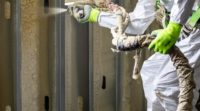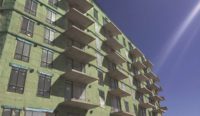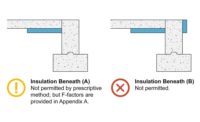Insulation Aids in Harsh Environments

All photos courtesy of Polyseal Insulation.





Located about 145 miles northeast of Fairbanks, Fort Yukon in Alaska holds the record for the coldest temperature ever recorded in the state, a remarkable -78 degrees Fahrenheit. Settled originally during the gold rush, the U.S. Air Force established a radar base there in the 1950s. More recently, the base changed hands to the country’s newly established Space Force and that is when general contractor Arctec called for energy efficiency upgrades to the base’s main barracks facility.
As its record temperatures indicate, Fort Yukon is a harsh environment. Extreme cold coupled with high winds had been causing the pipes under the barracks, which were heated to 180 degrees, to freeze. The structure’s fiberglass batting insulation had failed to perform under such intense conditions. Thus, Arctec called upon Palmer, Alaska-based Polyseal Insulation to enhance the insulation.
“We had worked with Arctec on a number of other projects in remote parts of Alaska, some being military domes” says Paul Broderson, general manager and owner of Polyseal Insulation. “We also had experience with projects similar to this one.”
Polyseal’s team—which included SPFA PCP certified master installer Matthew Wirtanen, Logan Korpela, Sam Wirtanen and Trace Muonio—focused their attention to the 17,000-square-foot utilidor area beneath the barracks, including the floor underside and exterior walls.
“Like other structures in this region, the barracks was built on pilings, or piers, because the ground is so unstable,” says Broderson. “Because of the structure’s design, a lot of wind travels underneath the floors. There’s no crawl space to block it so the building gets even colder.”
With Polyseal’s extensive work in Alaska, the team knew closed cell spray foam was the only insulation that would do the job. “The temperatures are too extreme here, nothing else works,” adds Broderson.
Polyseal selected HEATLOK HFO Pro, a closed cell spray foam option manufactured by Huntsman Building Solutions, for the project. Because of its high R-value of 7.5 per inch, HEATLOK HFO Pro lowers energy consumption and costs. The material is an excellent air sealant, reduces heat loss, and eliminates air infiltration and exfiltration. DC-315 was also applied as an additional thermal barrier. With an industry-leading spread rate, the intumescent paint’s single-coat coverage reduces labor and material costs and is easily applied with a fast turnaround time.
One of the primary issues with the utilidor area was it’s a very confined space, significantly limiting the applicators’ access. To combat this, the teams’ respirators were all equipped with scroll screens, which always gave them full visibility to ensure proper quality, as well as depth of the HEATLOK foam.
Ventilation was another key consideration. Air mover trunks were placed in various locations to ensure proper venting. The installers also wore full fresh air respirators, at all times.
“Because the utilidor necked down to only a few feet tall in certain areas, the crew alternated sprayers, passing the gun at set intervals to maintain a measured, sustainable pace during application,” says Broderson.
The challenges onsite were overcome, but only after addressing many before even getting there.
“As you can imagine, we had to undergo a serious security clearance process to even be allowed on the base,” says Broderson. “Additionally, the deck can be stacked against you when completing jobs in rural Alaska. You can’t miss a single item when prepping and mobbing out as it is logistically impossible to get items in on time if they are missed in the prep phase.”
Rigorous background checks were completed for every crew member and, because of that, no crew members could be swapped out if someone got sick. Knowing materials and equipment could not be flown in piecemeal, a lot of planning took place ahead of time. With no road access, a plane was also chartered to get the Polyseal crew to the base.
On top of that, Polyseal had to address the temperature sensitivity of the spray foam, as well as the power fluctuations of the diesel generator they were using.
“It’s important to keep the materials at a constant temperature and to make sure they don’t experience a cold shock at night,” says Broderson. “In the absence of a spray foam rig, our crew commandeered a Conex shipping container box available on the site and created a mobile spray foam shack. We retrofitted the container to house all our pumps and materials, tied in power and air, and got it to work for this longer-term spray foam application.”
All of Polyseal Insulation’s efforts paid off in the end. After 19 days onsite, the team’s resulting insulation solution rendered a staggering R-value of 45, with the utilidor roof and walls entirely insulated from the extreme temperatures and freezing wind.
“Arctec reported back that the entire building is now much warmer and that no pipes have frozen since,” says Broderson.
In a nod to Polyseal Insulation’s incredible work on the Fort Yukon LRRS Barracks, its team was awarded a 2023 SPFA National Industry Excellence Award for Commercial Enclosure SPF.
Looking for a reprint of this article?
From high-res PDFs to custom plaques, order your copy today!









